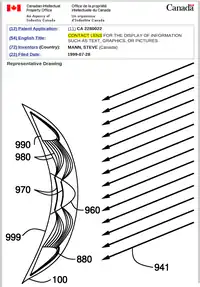
Bionic contact lenses are devices that, it is proposed by the manufacturers and developers, could provide a virtual display that could have a variety of uses from assisting the visually impaired to video gaming.[1] The device will have the form of a conventional contact lens with added bionics technology in the form of a head-up display,[2] with functional electronic circuits and infrared lights to create a virtual display[3] allowing the viewer to see a computer-generated display superimposed on the world outside.[4]
Proposed components
An antenna on the lens could pick up a radio frequency.[5]
In 2016, work on Interscatter[6] from the University of Washington has shown the first Wi-Fi enabled contact lens prototype that can communicate directly with mobile devices such as smart phones at data rates between 2–11Mbit/s.[7]
Development
Development of the first contact lens display began in the 1990s.[8][9]
Experimental versions of these devices have been demonstrated, such as one developed by Sandia National Laboratories.[10] The lens is expected to have more electronics and capabilities on the areas where the eye does not see. Radio frequency power transmission and solar cells are expected in future developments.[11] Recent work augmented the contact lens with Wi-Fi connectivity.[7]
In 2011, a functioning prototype with a wireless antenna and a single-pixel display was developed.[12]
Previous prototypes proved that it is possible to create a biologically safe electronic lens that does not obstruct a person’s view. Engineers have tested the finished lenses on rabbits for up to 20 minutes and the animals showed no problems.[13]
See also
References
- ↑ Fahey, Mike (January 17, 2008). "Bionic Eyes Could Change The Face Of Gaming". Archived from the original on 2008-01-20. Retrieved 2008-01-23.
- ↑ "'Bionic Lens' Adds Computing Power to Sight". Discovery News. 2008-02-05. Archived from the original on 2012-10-12. Retrieved 2008-02-08.
- ↑ "A single pixel contact lens display". Next Big Future. November 22, 2011. Archived from the original on 2011-12-03. Retrieved 2011-12-03.
- ↑ Hickey, Hannah (January 17, 2008). "Bionic eyes: Contact lenses with circuits, lights a possible platform for superhuman vision". University of Washington. Archived from the original on 2008-01-20. Retrieved 2008-01-23.
- ↑ NM Farandos; AK Yetisen; MJ Monteiro; CR Lowe; et al. (2014). "Contact Lens Sensors in Ocular Diagnostics". Advanced Healthcare Materials. 4 (6): 792–810. doi:10.1002/adhm.201400504. PMID 25400274. S2CID 35508652.
- ↑ "Interscatter". interscatter.cs.washington.edu. Retrieved 2016-09-28.
- 1 2 Emerging Technology from the arXiv. "First Wi-Fi-Enabled Smart Contact Lens Prototype". Retrieved 2016-09-28.
- ↑ Canadian Patent Application 2280022, CONTACT LENS FOR THE DISPLAY OF INFORMATION SUCH AS TEXT, GRAPHICS, OR PICTURES, LENTILLE CORNEENNE POUR L'AFFICHAGE D'INFORMATIONS SOUS FORME DE TEXTE, DE GRAPHIQUES OU D'IMAGES
- ↑ Intelligent Image Processing, John Wiley and Sons, 2001, 384 pages, ISBN 0-471-40637-6
- ↑ "Researchers Develop Bionic Contact Lens". Fox News. 2008-01-18. Archived from the original on 2008-01-21. Retrieved 2008-01-23.
- ↑ "Bionic Vision". Archived from the original on 2008-03-23. Retrieved 2008-01-23.
- ↑ Lingley, A. R.; Ali, M.; Liao, Y.; et al. (2011). "A single-pixel wireless contact lens display". Journal of Micromechanics and Microengineering. 21 (12): 125014. Bibcode:2011JMiMi..21l5014L. doi:10.1088/0960-1317/21/12/125014. S2CID 40131159.
- ↑ Nelson, Bryn. "Vision of the future seen in bionic contact lens". NBC News. Retrieved 2008-01-23.